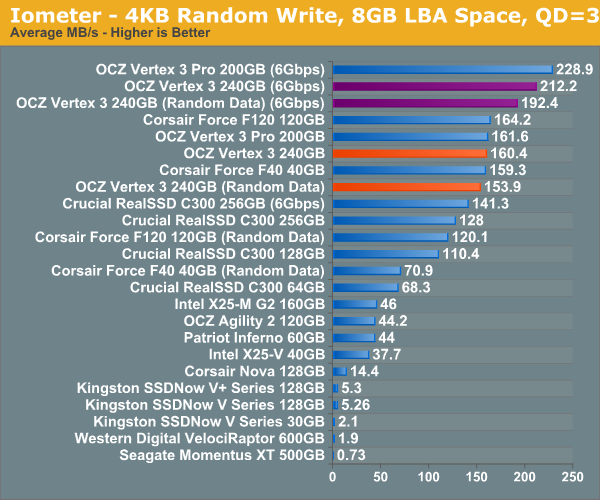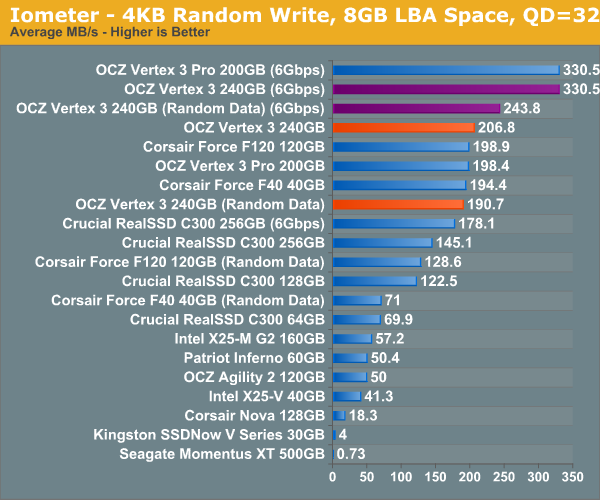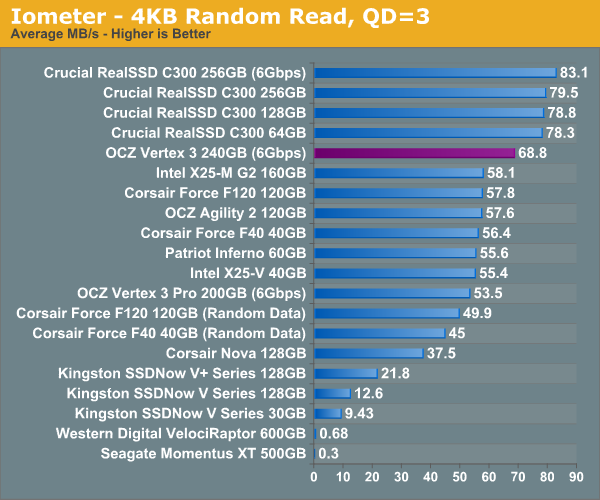OCZ Vertex 3 Preview: Faster and Cheaper than the Vertex 3 Pro
by Anand Lal Shimpi on February 24, 2011 9:02 AM ESTRandom Read/Write Speed
The four corners of SSD performance are as follows: random read, random write, sequential read and sequential write speed. Random accesses are generally small in size, while sequential accesses tend to be larger and thus we have the four Iometer tests we use in all of our reviews.
Our first test writes 4KB in a completely random pattern over an 8GB space of the drive to simulate the sort of random access that you'd see on an OS drive (even this is more stressful than a normal desktop user would see). I perform three concurrent IOs and run the test for 3 minutes. The results reported are in average MB/s over the entire time. We use both standard pseudo randomly generated data for each write as well as fully random data to show you both the maximum and minimum performance offered by SandForce based drives in these tests. The average performance of SF drives will likely be somewhere in between the two values for each drive you see in the graphs. For an understanding of why this matters, read our original SandForce article.

Many of you have asked for random write performance at higher queue depths. What I have below is our 4KB random write test performed at a queue depth of 32 instead of 3. While the vast majority of desktop usage models experience queue depths of 0 - 5, higher depths are possible in heavy I/O (and multi-user) workloads:












85 Comments
View All Comments
swaaye - Thursday, February 24, 2011 - link
It'll depend on how fast your CPU is because it will become the bottleneck if it's not already.Mumrik - Thursday, February 24, 2011 - link
"Order enough controllers and you get a special firmware, otherwise you’re stuck with the stock SF-2200 firmware.(...)I do wish SandForce would just stick to a single spec and not play these sorts of games but that’s just how business works unfortunately."
Is it really? I've never heard of anything similar elsewhere in the storage space. This really sounds to me like the kind of thing you should keep pushing them on Anand....
taltamir - Thursday, February 24, 2011 - link
so... 7 "models" which are the exact same chip with different firmware / different configuration (supercap, amount of NAND, etc)And even within those so called "models" there is different levels of performance capping in firmware due to various exclusivity contracts which are not actually being reported or represented in the chip's name?
I am liking sandforce less and less.
TGressus - Thursday, February 24, 2011 - link
+1It's even more egregious when vendors are sending the reviewers pre-release samples that may or may not represent the final retail product.
taltamir - Thursday, February 24, 2011 - link
you are correct, that does make it even worse.jaydee - Thursday, February 24, 2011 - link
Interesting read from a theoretical perspective, but it would be far more useful for your readership to have a roundup involving 60-120GB SSD's. I can find benchmarks on budget video cards, cpu's, and read reviews on budget motherboards. I do realize there are no 60-120GB Vertex 3's available, but 6-9 months after launch I still have no idea how (for instance) the Sandforce, JMicron, Samsung, Indillinx, Marvell, Intel, Toshiba 60-90GB SSD's benchmark against each other considering they all scale down differently from the 240GB models which are often reviewed.240GB SSD's are neat, but not affordable for many.
86waterpumper - Thursday, February 24, 2011 - link
I agree, the 128gb size seems to be the sweet spot, that is what I've decided to go with, just not surewhether it will be the newest sandforce or the c400. I wish we could get some testing on the amd
motherboard controllers too. I know intel is more popular right now but amd is still a viable option
for many. I would think this is especially important since amd finally released a ahci driver not too
long ago, but I haven't heard much about how good it is.
ol1bit - Thursday, February 24, 2011 - link
I can't believe the jump, Intel better be on their game or they might find themselves without a market anymore.My Intel 80gb is old after 1.5 years! LOL
seapeople - Thursday, February 24, 2011 - link
Sell an x25m g2 for $1.5/GB and they are right back on top of the value/money game. Especially when you consider issues like reliability reputation versus these new drives. I wonder what the profit margin on these drives are... There might be a lot of leeway to drop price to capture market on these, considering their "real" competitors are HD's.boxleitnerb - Thursday, February 24, 2011 - link
Hey Anand,I was wondering if you're considering writing about the CPU-SSD dynamic in a future article. As I understand it, the SSDs can serve requests so fast that in some scenarios the CPU again becomes the limiting factor.
I would be especially interested in common tasks like virus scanning, gaming/application load times/installation and windows startup. I know this could be alot of work, so maybe you can pick only one or two of these tasks and analyze them with CPUs with a different number of cores and clock speeds.
What do you think about it?